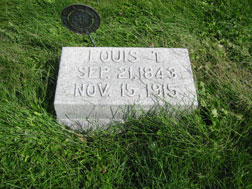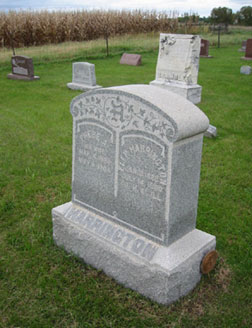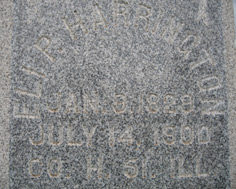
Louis T. Genung, Company H
Family Headstone
Hastings Cemetery, Hastings Iowa
Louis Thomas Genung was born September 21, 1843, in Port Byron, Illinois. He died November 15, 1915, in Glenwood, Iowa.
Genung served three months in the three-month 13th Illinois Infantry and then enlisted in the Fifty-First with numbers of the men and boys of Port Byron, Illinois.
WOUNDED AT JASPER. In mid-October 1863, during the siege of Chattanooga, Genung was part of a detail under the command of Sergeant Ivan Bailey of Company C which was sent from Chattanooga to Bridgeport, Alabama to guard a wagon train carrying rations. On October 16, as the detail was underway, near the town of Jasper (about 15 miles north of Bridgeport), Genung was shot by enemy sharpshooters just as the detail halted to go into camp in the evening. Bailey wrote, "I was standing but a few feet from him when he was shot and I was the first one to take hold & help him to an easy position." Genung wrote, "After being wounded, I was loaded into the rear wagon of our empty train, which was going to Bridgeport & which was being driven by a negro, & I saw and spoke to no one except said negro and the wagon boss in charge of said train... I rode in said wagon, was knocked into a stream called Battle Creek near Jasper when the mules were drowned & I was nearly so. The next day I was taken to Bridgeport & put into Hospital Oct 18th." Bailey recalled, "I never saw him [Genung] since until the 28th of September 1887 at the G.A.R. encampment at St. Louis, Mo."
Genung returned to the regiment in time for its march to East Tennessee in December, 1863 to support Burnside against Longstreet. Company-mate Cyrus Jacobs recalled that Genung was "rather lame", though two months of recovery time had intervened. In East Tennessee at Blaine's Crossroads Genung reenlisted with many others of the regiment at the end of 1863.
FRANKLIN: HE DID NOT GET TO THE SECOND LINE OF WORKS. Genung was with the regiment through the Georgia Campaign of May-September 1864. He was unscathed in Georgia, but his luck turned at the Battle of Franklin, Tennessee on November 30, 1864. Genung carried the national flag and his fellow—likewise from Port Byron—Kiser Lansdown carried the regimental flag.
The Fifty-First was in one of the two brigades positioned by Brigadier General George Wagner, absurdly, a half mile in front of the main line of fortifications. Opdycke, in command of Wagner's third brigade, with intelligent insubordinatoin, refused to position his brigade with the other two as ordered. Predictably, the attacking Confederate army overran the two brigades. Cyrus Jacobs of the Fifty-First recalled, "I was in line of battle with our Regt out in front of the main line and after the rebels had made several charges and had flanked us & some of the enemy had gained our rear, we started to retreat to the second line which was about a half a mile to our rear. Louis T. Genung had the colors on that day and started with us to the rear. I did not see him when he was wounded but know from report that he was bayoneted. I also know that he did not get to the second line of works." Thomas Gregg of Company H said, "I know he was the color bearer at said battle of Franklin - and was strong and healthy - we left him on the field."
James Calvert, who was also taken captive on November 30, wrote, "I did not see him (Genung) after the battle until I saw him at an old stone fort at Columbia, Tenn three or four days after the battle. Then I helped care for him and to dress a bayonet wound in his abdomen. I got water for him at the same time.... I know he came with me from Franklin because he had the colors in the battle."

Genung's own brief account read:
I was not with my company at said battle at all for the reason that I was carrying the flag, and Lansdown had the regimental colors. He was then & there mortally wounded. Our regiment was placed on the left side of the pike between Columbia and Franklin, some distance in front of the main line of battle, put there as I suppose by order of Genl Wagner. The 72 Ills Infy was also posted to our right and on the right of the pike.
We were driven back and on the way, as I was with the survivors of said regiments falling back to the main line, I was bayonetted by a Rebel, who with others had flanked us on the right, and taken prisoner. The two regiments had at the pike broken the Rebel line, but their advance had carried the two sections of their line to a point between us and our main line, so that without knowing it, until it was too late, by going towards our own line I was liable to run into the rebel line. At the time I was wounded and captured there was so far as I know or believe no member of my company or regiment immediately present and I do not know of any human being aside from the rebels and myself who have any "personal knowledge" of the immediate transaction. None of the rebels were or are known to me either personally or otherwise, and it is simply a matter of impossibility for me to produce the evidence of eyewitnesses to the occurrence.
Immediately after I was captured, I was taken to the rear and from that moment I never was with my company or regiment again and never saw any of them until after the close of the war, I being taken to Columbia & from there to the rebel prison at Cahawba, Alabama.
Most of his regimental comrades who were captured at Franklin were imprisoned at Andersonville. Presumably, Genung's wound prevented his being shipped off to Andersonville with the others; and, when it was time for Genung to be held in some Confederate prison, Andersonville was endangered by Federal movements in Georgia, and so Genung was sent to Alabama.
He was "receipted for" at Vicksburg on April 18, 1865 and released on parole. On April 25 he reported to the parole camp at Benton Barracks, St. Louis. He never returned to active service with the regiment after Franklin and was mustered out of the service in June 1865. He held the rank of sergeant at muster-out.
POST-WAR YEARS. Back home in Rock Island County, Illinois, on June 20, 1865, Genung married Clara F. Pruden. On September 20, 1865, Genung and Clara, along with the family of Phelix Snider, after a month "fixing up our wagons and arranging other matters", started the trek by team and wagon to Saunders County, Nebraska, arriving there on October 22. Snider wrote that much of the time his family and the Genung family lived 12 miles apart, "but it was simple open prairie, no person lived between us." In 1867, he left Nebraska and spent two years "on the Western Plains and in the mountains."
During his time on the plains and in the mountains, Genung had ceased living with Clara; she filed for divorce in 1869 and the divorce was finalized in 1871. In 1870, Genung came back east and settled in Hastings, Mills Co., Iowa in the southwest corner of the state. On March 3, 1872, in Hastings at the home of the bride's father, Genung and Julia A. Anderson were married (and over the next fourteen years had seven children). In Iowa, he owned land, conducted a farming operation, studied law privately, and was admitted to the bar in 1875. He opened a law practice in Hastings and was twice the mayor of that mini-town. He served several terms as Mills County Attorney.
He and his son Clyde opened a law practice, Genung & Genung, in the town of Glenwood, the Mills County seat. Genung moved from Hastings to Glenwood in 1890.
Genung ran unsuccessfully for Congress in 1896. He served several times as a delegate to the Democratic National Convention.
After Effects: "He Was Under My Observation Almost Daily". From late 1864 at Cahaba and for the rest of his life, Genung suffered the effects of his war wound. The wound to the ankle healed well. But the bloody piles tormented Genung to his grave. His doctors said that he was confined to his bed for several weeks three or four times a year when there were flare-ups, and otherwise the least exertion would aggravate the ever-present condition. This is not one of the more glamorous ways to be a veteran resting on a veteran's laurels. The bayonet wound also caused a "condition of protrusion of the gut to the extent of prolapsus." One of his doctors wrote, "He was under my observation almost daily." Another of his doctors wrote that Genung's condition was "one of the most severe that I have ever been called to treat."

